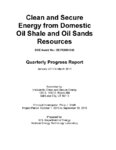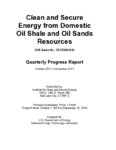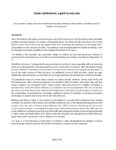TO
Filters: Collection: "ir_eua" Type: "Text"
| Title | Date | Subject | Description | ||
|---|---|---|---|---|---|
| 326 |
 |
Clean and secure energy from domestic oil shale and oil sands resources: Quarterly progress report: April 2013 to June 2013 | 2013 | Quarterly Progress Report; April 2013 to June 2013; DE-FE0001243; Oil Shale; Oil Sands; CO2 management; Uinta Basin; Greenhouse gas; GHG emissions; oxyfiring; Utah; WTP; Ex situ; In situ | The Clean and Secure Energy from Domestic Oil Shale and Oil Sands Resources program, part of the research agenda of the Institute for Clean and Secure Energy (ICSE) at the University of Utah, is focused on engineering, scientific, and legal research surrounding the development of these resources in ... |
| 327 |
 |
Clean and secure energy from domestic oil shale and oil sands resources: Quarterly progress report: January 1, 2010 to March 31, 2010 | 2010-05-13 | ICSE; University of Utah; CO2 capture; Mahogany zone; Green River Formation; Utah; Uinta Basin; Oil sands; Crude oil refining; International Flame Research Foundation; Liquid fuel production; In-situ thermal treatment; Oil shale; Pyrolysis | The Clean and Secure Energy from Domestic Oil Shale and Oil Sands Resources program is part of the research agenda of the Institute for Clean and Secure Energy (ICSE) at the University of Utah. In this quarter, the Clean and Secure Energy program continued its focus on enhancing industrial, national... |
| 328 |
 |
Clean and secure energy from domestic oil shale and oil sands resources: Quarterly progress report: January 2011 to March 2011 | 2011-04-01 | ICSE; Oil shale; Oil sands; University of Utah; Utah; Oxy-gas; Kerogen; X-ray fluorescence analysis; Thermogravimetric analyzer; TGA; Lattice Boltzmann simulation; Flameless oxy-gas process heaters; CO2 capture; American Shale Oil; AMSO; Greenhouse gas emissions; GHG | The Clean and Secure Energy from Domestic Oil Shale and Oil Sands Resources program is part of the research agenda of the Institute for Clean and Secure Energy (ICSE) at the University of Utah. In this quarter, the Clean and Secure Energy program held a Project Review meeting on the University of Ut... |
| 329 |
 |
Clean and secure energy from domestic oil shale and oil sands resources: Quarterly progress report: January 2012 to March 2012 | 2012-04 | ICSE; University of Utah; Green River Basin; CO2 capture; Oil sands; Crude oil refining; International Flame Research Foundation; IFRF; Oil shale; Pyrolysis; Thermogravimetric analysis; TGA; TEA-C burner; Uinta Basin; Flameless oxy-gas process heaters; Efficient CO2 capture; Liquid Fuel Production ... | The Clean and Secure Energy from Domestic Oil Shale and Oil Sands Resources program is part of the research agenda of the Institute for Clean and Secure Energy (ICSE) at the University of Utah. In outreach efforts, ICSE participated in a session on oil sands at the Utah Governor's Annual Energy Deve... |
| 330 |
 |
Clean and secure energy from domestic oil shale and oil sands resources: Quarterly progress report: January 2013 to March 2013 | 2013 | ICSE; Domestic oil shale; Oil sands; CO2 management; AMSO; Uinta Basin; Kerogen | The Clean and Secure Energy from Domestic Oil Shale and Oil Sands Resources program, part of the research agenda of the Institute for Clean and Secure Energy (ICSE) at the University of Utah, is focused on engineering, scientific, and legal research surrounding the development of these resources in ... |
| 331 |
 |
Clean and secure energy from domestic oil shale and oil sands resources: Quarterly progress report: July 2010 to September 2010 | 2010-10 | ICSE; Oil shale; Oil sands; University of Utah; Marriott Library; Macroscale CO2 analysis; CO2 capture; Flameless oxy-gas process heaters; Liquid fuel production; In-situ thermal processing | The Clean and Secure Energy from Domestic Oil Shale and Oil Sands Resources program is part of the research agenda of the Institute for Clean and Secure Energy (ICSE) at the University of Utah. In this quarter, the Clean and Secure Energy program was involved in multiple technology transfer and outr... |
| 332 |
 |
Clean and secure energy from domestic oil shale and oil sands resources: Quarterly progress report: July 2011 to September 2011 | 2011-09 | ICSE; University of Utah; Uinta Basin; Oil and gas production; Utah Division of Oil, Gas, and Mining; NOx emissions; American Shale Oil; AMSO; Flameless oxy-gas process heaters; Efficient CO2 capture | The Clean and Secure Energy from Domestic Oil Shale and Oil Sands Resources program is part of the research agenda of the Institute for Clean and Secure Energy (ICSE) at the University of Utah. In this quarter, the Clean and Secure Energy program cosponsored the 2011 Energy Forum, which was held in ... |
| 333 |
 |
Clean and secure energy from domestic oil shale and oil sands resources: Quarterly progress report: July 2012 to September 2012 | 2012-10 | ICSE; Kerogen liquefaction; Oil shale thermal treatment; Trondheim, Norway; Statoil; Uinta Basin; Greenhouse gases; Well drilling; White River oil shale samples; Demineralized kerogen pyrolysis; Oil shale; Char; American Shale Oil; AMSO; Genie Energy; TOTAL | The Clean and Secure Energy from Domestic Oil Shale and Oil Sands Resources program is part of the research agenda of the Institute for Clean and Secure Energy (ICSE) at the University of Utah. In its outreach efforts this quarter, ICSE finalized materials for a short course on kerogen liquefaction ... |
| 334 |
 |
Clean and secure energy from domestic oil shale and oil sands resources: Quarterly progress report: July 2013 to September 2013 | 2013 | Quarterly progress report; July 2013 to September 2013; DE-FE0001243; CO2 management; oxyfiring; CO2 capture; Unconventional fuels; Uinta Basin; Utah; Oil shale; Oil sands; Greenhouse gas control; NER; NEER; GHG; In situ; Ex situ | Disclaimer: "This report was prepared as an account of work sponsored by an agency of the United States Government. Neither the United States Government nor any agency thereof, nor any of their employees, makes any warranty, express or implied, or assumes any legal liability or responsibility for th... |
| 335 |
 |
Clean and secure energy from domestic oil shale and oil sands resources: Quarterly progress report: October 2009 to December 2009 | 2010-02-03 | ICSE; Clean and Secure Energy program; CASE; Itasca Group; Red Leaf Resources; Enshale's; Vernal, Utah; oxy-fuel; CO2 capture; Oil shale; Oil sands; Crude oil; CO2 emissions; International Flame Research Foundation; Pyrolysis; Lattice Boltzmann; Kerogen; Oil recovery simulation; TGA; Dry shale; Pyro... | The Clean and Secure Energy from Domestic Oil Shale and Oil Sands Resources program is part of the research agenda of the Institute for Clean and Secure Energy (ICSE) at the University of Utah. The program was officially launched on October 1, 2009. The project management plan was submitted for revi... |
| 336 |
 |
Clean and secure energy from domestic oil shale and oil sands resources: Quarterly progress report: October 2010 to December 2010 | 2011-01 | ICSE; Oil shale; Oil sands; University of Utah; Marriott Library; Macroscale CO2 analysis; CO2 capture; Flameless oxy-gas process heaters; Liquid fuel production; In-situ thermal processing | The Clean and Secure Energy from Domestic Oil Shale and Oil Sands Resources program is part of the research agenda of the Institute for Clean and Secure Energy (ICSE) at the University of Utah. In this quarter, the Clean and Secure Energy program circulated External Advisory Board recommendations an... |
| 337 |
 |
Clean and secure energy from domestic oil shale and oil sands resources: Quarterly progress report: October 2011 to December 2011 | 2012-01 | ICSE; University of Utah; AMSO; American Shale Oil; Strategic Alliance Reserve; SAR; Utah Division of Oil, Gas, and Mining; DOGM; Large eddy simulation; LES; International Flame Research Foundation; IFRF; Flamelet; Pyrolysis; Kerogen; Thermogravimetric analysis; TGA; CO2 enhanced oil recovery; EOR | The Clean and Secure Energy from Domestic Oil Shale and Oil Sands Resources program is part of the research agenda of the Institute for Clean and Secure Energy (ICSE) at the University of Utah. The Clean and Secure Energy program hosted an External Advisory Board on November 1-2, 2011 and the kickof... |
| 338 |
 |
Clean and secure energy from domestic oil shale and oil sands resources: Quarterly progress report: October 2012 to December 2012 | 2013-01 | ICSE; Oil shale; oil sands; CO2 management; Uinta Basin; Liquid fuel production; In-situ thermal processing; White River oil shale; Green River Formation; American Shale Oil; AMSO; X-ray flourescence; Pyrolysis; Demineralized kerogen | The Clean and Secure Energy from Domestic Oil Shale and Oil Sands Resources program, part of the research agenda of the Institute for Clean and Secure Energy (ICSE) at the University of Utah, is focused on engineering, scientific, and legal research surrounding the development of these resources in ... |
| 339 |
 |
Clean and secure energy from domestic oil shale and oil sands resources: Quarterly progress report: October 2013 to December 2013 | 2014 | ICSE; Quarterly report; Clean and secure energy; Oil shale; Oil sands; Uinta Basin; CO2 management; AMSO; Greenhouse gas control; Shale formation; In situ; Ex situ; TEA-C | EXECUTIVE SUMMARY The Clean and Secure Energy from Domestic Oil Shale and Oil Sands Resources program, part of the research agenda of the Institute for Clean and Secure Energy (ICSE) at the University of Utah, is focused on engineering, scientific, and legal research surrounding the development of t... |
| 340 |
 |
Clean and secure energy from Utah's oil shale and oil sands resources: Environmental, legal and policy framework | 2010-04-28 | ICSE; Land use; Water availability; Produced water; Utah; Colorado; Colorado River | This poster addresses major challenges to land use, water availability, and produced water. |
| 341 |
 |
Clean coal program research activities: Final report: Reporting period 07/01/2006-05/31/2009 | 2010-05 | Environment; Emissions; NOx; SOx; Mercury emission; CO2 emissions; Utah Clean Coal Program; Carbon capture and sequestration; CCS; Green field plants; Simulation; Mergury control; Oxycoal combustion; Gasification; Sequestration; Chemical looping combustion; CLC; Materials investigations; NETL; Coal ... | Although remarkable progress has been made in developing technologies for the clean and efficient utilization of coal, the biggest challenge in the utilization of coal is still the protection of the environment. Specifically, electric utilities face increasingly stringent restriction on the emission... |
| 342 |
 |
Clearing the Path | 2018-01 | Student success; University of Utah | A strategic student success agenda. |
| 343 |
 |
Clearn combustion, a path to net zero | Use of fossil fuels as the major source of energy is one of the main sources of GHG emissions that contribute to global warming. However, for at least a foreseeable future, the world will still continue to rely on fossil fuels to sustain the economy and the quality of life. IEA is evaluating the pat... | ||
| 344 |
 |
Clearsign core process burners and boiler burners - burner scaling and field results | 2022 | During previous AFRC Industrial Combustion Symposia, ClearSign Technologies Corporation introduced its ClearSign Core technology currently used in our Ultra Low NOx burner products. These ClearSign Core products have now been developed for different types of equipment applications to meet stringent ... | |
| 345 |
 |
ClearSign eye™: pilot sensor | Clearsign Technologies Corp. has developed and tested a novel, capacitive based flame sensor for use on existing burners in a variety of industrial combustion applications including process burners, boiler burners and flares. ClearSign has developed two probe designs. The first probe design is compa... | ||
| 346 |
 |
Climate change 2007: The physical science basis--summary for policymakers | 2007-02 | Climate change; Greenhouse gases; Aerosols; Solar radiation; Radiative forcing; Third Assessment Report; TAR; Solar activity; Carbon dioxide; CO2; Methane; CH4; Nitrous oxide; N2O; Fossil Fuel; Land use; Agriculture; Land surface properties; Warming; Melting of snow and ice; Rising seal level; Globa... | The Working Group I contribution to the IPCC Fourth Assessment Report describes progress in understanding of the human and natural drivers of climate change1, observed climate change, climate processes and attribution, and estimates of projected future climate change. It builds upon past IPCC assess... |
| 347 |
 |
Climate change regulation via the back door | 2011-05-17 | ||
| 348 |
 |
Climate change--current understanding and implications | 2008-05-23 | Global warming; Climate change; Coal; CO2; Carbon dioxide; Temperature; Radiative Forcing; Emissions; Greenhouse gases; Arctic warming; Sea level rise; Fossil fuel; Renewable | Four Primary Questions: 1-Is global warming (climate change) occurring? 2-What is the cause? 3-What will be the consequences? 4-What can/should we do? |
| 349 |
 |
Closed loop flare control using a video imaging spectral radiometer | Video Imaging Spectral Radiometry (VISR) has emerged as the only practical method to directly and continuously monitor flare performance. The VISR method provides real time measurements of flare combustion efficiency (%) and a smoke index (0-10) at a 1-sec temporal resolution. In addition to these t... | ||
| 350 |
 |
Co-simulation for design and optimization of advanced energy systems with carbon capture | 2009-10 | NETL; APECS; IGCC; U.S. Energy challenges; Design and optimization of advanced energy systems; CFD; Reduced Order Models; ROMs; Carbon capture; Virtual power plant; Carbon management; Fossil Energy Industry; Ultra-supercritical; USC; Oxy-combustion; Chemical looping combustion; CLC; Integrated gasif... | Outline of Presentation: 1-Introduction: -U.S. Energy Challenges -Design and Optimization of Advanced Energy Systems; Simulation Tools and Challenges 2-Advanced Process Engineering Co-Simulation (APECS): -Basic Features; Process/CFD Workflow/Integration, Engineering Knowledge Manager(Trademark), Red... |
